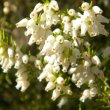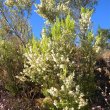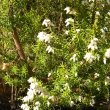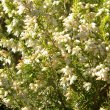| Botanical Name |
|
| Family |
Ericaceae - The Erica and Heather family.
|
| Pronunciation |
|
| Common Name(s) |
English: Water tree erica; Water Heath; Sweet-scented heath
Afrikaans: Reisheide; Waterboomheide
|
| Plant Group |
- Fynbos Certain plants endemic to the areas of the Western Cape of South Africa that have a Mediterranean climate of cold, wet winters and hot, dry summers.
- Shrub A woody plant of relatively low height, having several stems arising from the base and lacking a single trunk; a bush.
|
| Plant Size |
- Large
| Tree | 18m to 25m |
| Shrub | 3m to 4m |
| Perennial/ground cover | 75cm to 1m |
| Bulb | 80cm to 1.2m |
| Succulent | 1m to 1.5m |
|
| Position |
- Light or Dappled Shade Found below trees with sparse, open foliage. Ideal for the protection of herbaceous plants.
- Partial Shade The area is in shade for part of the day and in full sun for part of the day.
- Sun The area is in full sun for all or most of the day, all year round.
|
| General Information |
- Drought Tolerance: Moderate The plant is moderately adapted to arid conditions and can survive short periods of drought and high temperatures without extra water.
- Evergreen Plants that have leaves all year round.
- Fragrant / Aromatic These plants posses a strong, usually pleasant odour.
- Frost: Hardy The plant can withstand freezing temperatures or frost without artificial protection.
- Prune hard after flowering Fast growing shrubs that grow lanky within a season. Cut off branches and stems of these plants to a third of their original length. This will increase the yield of flowers, improve the plants shape and enhance the structural strength of main branches.
- Water Loving Plants need a regular supply of water and must not be allowed to dry out for any length of time.
- Wind Tolerant Plants able to withstand the effect of strong winds.
|
| Specific Information |
Erica caffra is a water-loving, sturdy shrub or small tree with long, thin, twiggy branches and narrow, almost needle shaped leaves up to 20 mm long. Young bark is grey while older bark is brown and deeply fissured. The flowers have a strong scent of honey. It grows naturally in a wide range of conditions as long as the soil in which it stands remains damp. It is at home in areas with winter, summer or year round rain, and in habitats with both high and fairly low yearly rainfall.
Note: A number of sources cite this as a protected species but I have found no evidence to support this. Please comment if you can supply me with a source for this claim.
|
| Ad Break |
|
| Flowers |
| Description |
small, bell- or urn-shaped, clustered along the upper parts of the stems
|
| Season |
- Winter to Summer Plants will seldom bloom for the entire season as given in the list, but should flower during a period within these parameters.
|
| Colour |
|
| Growth Rate |
- Moderate to Fast Specifying growth rate can be very misleading as there is considerable variation of growth rate depending on type and species of plant, available water, supplementary feeding, mulching and general care, as well as the plants suitability and adaptability to the garden environment.
|
| Plant Uses |
- Attracts bees, butterflies or other insects This plant attracts insects which can be food for birds or other creatures in your garden.
- Container Trees, shrubs and ornamental species that can adapt to growing in a restricted environment.
- Hedge Suitable trees or shrubs planted relatively close together so that the branches intertwine to create a barrier. This can be formal – the plants are regularly trimmed to produce a neat shape, or informal – the plants are left to themselves to create a natural hedgerow.
- Suitable for coastal gardens Plants adapted to dry, sandy soil, forceful wind, limited rainfall and intense sunlight.
- Suitable for smaller gardens Such plants do not have invasive root systems, remain small or controllable and can often be grown in containers.
- Water Features These plants may have dramatic, lush foliage or graceful form. They do not shed excessive leaves and do not have invasive root systems.
- Wetland
An area of land that is saturated with fresh or salt water and is a distinct ecosystem, with plants and wild life specifically adapted to and dependent on, a bog, fen, march or swamp.
- Wild Garden An indigenous garden planted for the benefit of wildlife and birds. Provides food, water, a variety of mini-biomes and no poisonous chemicals are used.
|
| Distribution and Habitat |
from Van Rhynsdorp to the Cape Peninsula, east to the Eastern Cape as far as the Free State. and north to KwaZulu-Natal and Lesotho, in mountain ravines, on cliffs with water seepage and along streams and rivers, in wet or damp places
|
| Planting Suggestions |
Choose a site where the plant will be constantly, even if only slightly, moist, but not actually in water. The edge of a swampy or marshy area or next to a stream or dam are good choices. When not in flower Erica caffra can be quite untidy so some cutting back after flowering may be necessary. It prefers acidic, moist or wet but non-stagnant, soil. Avoid manure and phosphates, and ensure plenty of humus/compost - about 50% of the soil mix. It can also adapt to clay, loam and peat soils but not to very sandy soil.
Do not disturb the root area if possible, at least until the plant is well established after a year or two.
|
| Medicinal Uses |
|
| Ad Break |
|








Discuss this plant
Share knowledge, ask a question or give an experience.